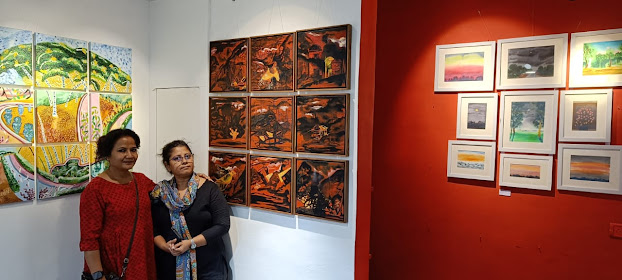Beyond the dictionary definitions of 'Painting' and 'Sculpture', is something that the artists define themselves. They refuse to be tamed by the limitations of the mediums, and device their own sense-making strategies. From Collage to wall-mounted sculpture, they challenge the hegemony of 'oil on canvas'. This show enumerates 10 such artists and their works, diverse from each other but definitive in their own way.
Curiously, the chronologically first works in this show are oils on canvas!
Sunil Gawde, back in the days when he was known as an abstract painter, sought the 'real' physical dimension of the paint he used. Eventually, it seems, he made the thick paint smile! Gawde's thick paint was a reminder that resulted from his action-oriented way to deal with his canvas. He first spread his paint on his canvas evenly, but was quick to unstable it with a large spatula. These works represent an important phase in the artist's career, before he took to conceptual works.
Santana Gohain, builds spaces within a given surface with many smaller surfaces. The space-defining role of colour is negated in her works. The works are as much about austerity of expression as about abundance of mark-making.
Perhaps Vanita Gupta explored the same path of subdued expression in her large drawings but here, her works with strands of torn paper ruminate on the very existence of mark-making, the senility of paper. No wonder that Vanita, who is also a poet, took to installation art only after these works.
Another artist who has passed his mid-career stage- H. G. Arunkumar, is here with his works that are now one of a kind: Arunkumar chose to do newspaper collages, but went on to draw over it and also added another layer of collaged images onto it, before treating these works for longevity.
Pooja Iranna's works are, if we may say- 'De-Collage', as they refer to one image painted on the jigsaw-like pieces. A mural-like quality is inherent in these works, after which Pooja turned to sculptures.
Himanshu Joshi explores every possibility of wall-mountable three-dimensional works, while using the element of light in his meticulously crafted paper-fold works. Recently, Himanshu has also turned to photo-collages with light.
Puneet Kaushik is known for his choice of colour as much as his use of beads and elements of embroidery. His wall-mounted works radiate the richness of his material, and at a closer look, evoke a melancholic joy.
Abhijit Pathak treats pieces of cloth as his terrain and marks his mindscapes over them. The transparency he maintains is flawless. Pathak provides a viewer with maps to her/his dreams.
Nilesh Kinkale, on the other hand, celebrates the ground reality; literally. He chooses a unique surface for art-making: Asphalt, commonly used for our roads. Nilesh's practice for nearly two and half decades has been based on celebrating the everyday, as many artists from Mumbai (since Prabhakar Barwe) have done. Yet, Nilesh works on his own terms and takes ample liberty to go beyond drawing-and-painting the everyday object. These objects are now embedded in Asphalt.
Smita Kinkale reconciles the mundane material with fantasy landscapes.
She bends, burns and blurs plastic sheets for her wall mounted works. The
potential of her works to challenge the aesthetic notions is acknowledged
internationally.
What binds these works is the quest for meanings. While these works may not send some explicit messages to a viewer who is eager to 'get it and go'; the artists have explored possibilities of their surfaces and materials to an extent that they know what it means to handle such a surface. The term 'layered meaning', is typically used in postmodern parlance to denote the diversity in decipherment. The artists, through their diverse approaches and choices, have all deciphered the strengths of their choice.
Abhijeet Tamhane
Mumbai. December 2023
-----------------------------------------------------------------------
Layered Meanings - Ten leading Contemporary Artists
Curated by Vibhuraj Kapoor
Abhijit Pathak / Arunkumar H.G / Himanshu Joshi / Pooja Iranna / Puneet Kaushik /
Nilesh Kinkale / Santana Gohain / Smita Kinkale/ Sunil Gawde / Vanita Gupta /
Date: 9th to 15 th Jan 2024 Time: 11am to 7pm
Venue: Jehangir art gallery
AC -2 , Kala Ghoda, Fort 400 001, Mumbai - India
www.gallerybeyond.in








.jpg)

.jpg)
.jpeg)
.jpeg)
.jpeg)
.jpeg)





.jpg)
.jpg)


.jpg)
